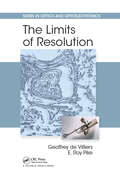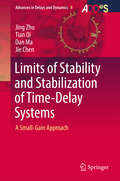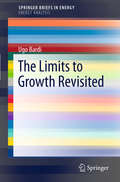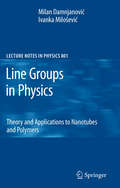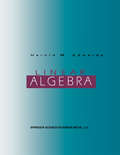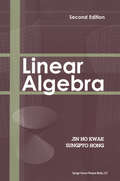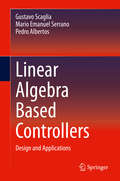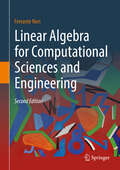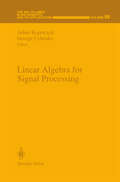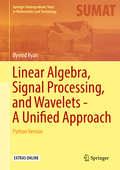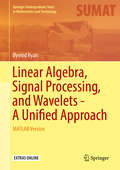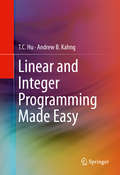- Table View
- List View
The Limits of Resolution (Series in Optics and Optoelectronics)
by Geoffrey de Villiers E. Roy Pike"This beautiful book can be read as a novel presenting carefully our quest to get more and more information from our observations and measurements. Its authors are particularly good at relating it." --Pierre C. Sabatier "This is a unique text - a labor of love pulling together for the first time the remarkably large array of mathematical and statistical techniques used for analysis of resolution in many systems of importance today – optical, acoustical, radar, etc…. I believe it will find widespread use and value." --Dr. Robert G.W. Brown, Chief Executive Officer, American Institute of Physics "The mix of physics and mathematics is a unique feature of this book which can be basic not only for PhD students but also for researchers in the area of computational imaging." --Mario Bertero, Professor, University of Geneva "a tour-de-force covering aspects of history, mathematical theory and practical applications. The authors provide a penetrating insight into the often confused topic of resolution and in doing offer a unifying approach to the subject that is applicable not only to traditional optical systems but also modern day, computer-based systems such as radar and RF communications." --Prof. Ian Proudler, Loughborough University "a ‘must have’ for anyone interested in imaging and the spatial resolution of images. This book provides detailed and very readable account of resolution in imaging and organizes the recent history of the subject in excellent fashion.… I strongly recommend it." --Michael A. Fiddy, Professor, University of North Carolina at Charlotte This book brings together the concept of resolution, which limits what we can determine about our physical world, with the theory of linear inverse problems, emphasizing practical applications. The book focuses on methods for solving illposed problems that do not have unique stable solutions. After introducing basic concepts, the contents address problems with "continuous" data in detail before turning to cases of discrete data sets. As one of the unifying principles of the text, the authors explain how non-uniqueness is a feature of measurement problems in science where precision and resolution is essentially always limited by some kind of noise.
The Limits of Resolution (Series in Optics and Optoelectronics)
by Geoffrey de Villiers E. Roy Pike"This beautiful book can be read as a novel presenting carefully our quest to get more and more information from our observations and measurements. Its authors are particularly good at relating it." --Pierre C. Sabatier "This is a unique text - a labor of love pulling together for the first time the remarkably large array of mathematical and statistical techniques used for analysis of resolution in many systems of importance today – optical, acoustical, radar, etc…. I believe it will find widespread use and value." --Dr. Robert G.W. Brown, Chief Executive Officer, American Institute of Physics "The mix of physics and mathematics is a unique feature of this book which can be basic not only for PhD students but also for researchers in the area of computational imaging." --Mario Bertero, Professor, University of Geneva "a tour-de-force covering aspects of history, mathematical theory and practical applications. The authors provide a penetrating insight into the often confused topic of resolution and in doing offer a unifying approach to the subject that is applicable not only to traditional optical systems but also modern day, computer-based systems such as radar and RF communications." --Prof. Ian Proudler, Loughborough University "a ‘must have’ for anyone interested in imaging and the spatial resolution of images. This book provides detailed and very readable account of resolution in imaging and organizes the recent history of the subject in excellent fashion.… I strongly recommend it." --Michael A. Fiddy, Professor, University of North Carolina at Charlotte This book brings together the concept of resolution, which limits what we can determine about our physical world, with the theory of linear inverse problems, emphasizing practical applications. The book focuses on methods for solving illposed problems that do not have unique stable solutions. After introducing basic concepts, the contents address problems with "continuous" data in detail before turning to cases of discrete data sets. As one of the unifying principles of the text, the authors explain how non-uniqueness is a feature of measurement problems in science where precision and resolution is essentially always limited by some kind of noise.
Limits of Stability and Stabilization of Time-Delay Systems: A Small-Gain Approach (Advances in Delays and Dynamics #8)
by Jing Zhu Tian Qi Dan Ma Jie ChenThis authored monograph presents a study on fundamental limits and robustness of stability and stabilization of time-delay systems, with an emphasis on time-varying delay, robust stabilization, and newly emerged areas such as networked control and multi-agent systems. The authors systematically develop an operator-theoretic approach that departs from both the traditional algebraic approach and the currently pervasive LMI solution methods. This approach is built on the classical small-gain theorem, which enables the author to draw upon powerful tools and techniques from robust control theory. The book contains motivating examples and presents mathematical key facts that are required in the subsequent sections. The target audience primarily comprises researchers and professionals in the field of control theory, but the book may also be beneficial for graduate students alike.
The Limits to Growth Revisited (SpringerBriefs in Energy)
by Ugo Bardi“The Limits to Growth” (Meadows, 1972) generated unprecedented controversy with its predictions of the eventual collapse of the world's economies. First hailed as a great advance in science, “The Limits to Growth” was subsequently rejected and demonized. However, with many national economies now at risk and global peak oil apparently a reality, the methods, scenarios, and predictions of “The Limits to Growth” are in great need of reappraisal. In The Limits to Growth Revisited, Ugo Bardi examines both the science and the polemics surrounding this work, and in particular the reactions of economists that marginalized its methods and conclusions for more than 30 years. “The Limits to Growth” was a milestone in attempts to model the future of our society, and it is vital today for both scientists and policy makers to understand its scientific basis, current relevance, and the social and political mechanisms that led to its rejection. Bardi also addresses the all-important question of whether the methods and approaches of “The Limits to Growth” can contribute to an understanding of what happened to the global economy in the Great Recession and where we are headed from there.
Limnische Ökologie (Teubner-Reihe Umwelt)
by Lothar KalbeIn diesem Lehrbuch werden die ökologischen Grundlagen der Limnologie und der angewandten Ökologie dargestellt. Im Mittelpunkt stehen die ökologischen Bedingungen für die Besiedlung der unterschiedlichen limnischen Ökosysteme mit Pflanzen und Tieren, die Klassifizierung der Gewässer und die Leistungen der Lebensgemeinschaften. Dabei wird der Leser mit der Belastbarkeit von Ökosystemen, den Problemen der Eutrophierung, der Selbstreinigung und der Bioproduktion sowie der Stabilität, Sanierung, Regeneration und Restaurierung geschädigter Systeme vertraut gemacht. Das Buch wendet sich vor allem an Studenten und an Praktiker.
Limnological Analyses
by Robert G. Wetzel Gene E. LikensIn this thoroughly updated third edition, the authors provide a series of carefully designed and tested field and laboratory exercises that represent the full scope of limnology. In using the text, students will gain a solid foundation in this complex, multidisciplinary field of ecology as they explore the physical, chemical, and biological characteristics of standing and running waters. The book illustrates accepted standard methods as well as modern metabolic and experimental approaches and their research applications. Each exercise is preceded by an introductory section and concludes with questions for students as well as suggestions for further reading. As a textbook, this is a highly structured, concise presentation with a research-oriented approach that openly invites active participation by students.
Limnological and Engineering Analysis of a Polluted Urban Lake: Prelude to Environmental Management of Onondaga Lake, New York (Springer Series on Environmental Management)
by Steven W. EfflerOnondaga Lake in Syracuse, New York is a model for the analysis and management of a polluted urban lake. Sometimes referred to as "the most polluted lake in the United States", Onondaga Lake is one of only two lakes for which a federal advisory body has been set up to guide environmental remediation. The recipient of significant municipal effluent and industrial waste for more than a century, Onondaga Lake has been the focus of intensive limnological investigation and extensive remediation efforts. This book is a comprehensive presentation of the scientific knowledge about Onondaga Lake, based on research coordinated by the Upstate Freshwater Institute. Onondaga Lake: Limnology and Environmental Management of a Polluted Urban Lake is the most complete case study of a lake, and will be of interest to water quality scientists, engineers and managers, as well as environmental engineers, modelers, and policymakers.
Limnology
by Jose Galizia Tundisi Takako Matsumura TundisiLimnology provides an in-depth and current overview of the field of limnology. The result of a major tour de force by two renowned and experienced experts, this unique and richly illustrated reference presents a wealth of data on limnology history, water as a substrate, lakes' origins and aquatic biota. Besides a general part, it gives special focu
Limnology, Climatology and Paleoclimatology of the East African Lakes
by Thomas C. Johnson Eric O. OdadaThe large lakes of the East African Rift Valley are among the oldest on Earth, and are vital resources for the people of their basins. They are unique among the large lakes of the world in terms of their sensitivity to climatic change, rich and diverse populations of endemic species, circulation dynamics and water-column chemistry, and long, continuous records of past climatic change. A comprehensive study of the large African lakes is long overdue. The scientific justification for such an effort is noted in the previous paragraph and is illustrated in great detail in this volume. Societal need for the sustainable utilization of these lakes offers an even more compelling reason for examination of biological food webs, water quality, and past climate variability in East Africa. The lakes provide the most important source of protein for the people of the African Rift Valley, and fish populations are shifting dramatically in response to fishing pressure, introduction of exotic species, land use impact on water quality, and perhaps climatic change. Current estimates of primary productivity, the underpinning of the food resource, are extremely crude and based on only a few spot measurements.
Limnology, Climatology and Paleoclimatology of the East African Lakes
by Thomas C. Johnson Eric O. OdadaThe large lakes of the East African Rift Valley are among the oldest on Earth, and are vital resources for the people of their basins. They are unique among the large lakes of the world in terms of their sensitivity to climatic change, rich and diverse populations of endemic species, circulation dynamics and water-column chemistry, and long, continuous records of past climatic change. A comprehensive study of the large African lakes is long overdue. The scientific justification for such an effort is noted in the previous paragraph and is illustrated in great detail in this volume. Societal need for the sustainable utilization of these lakes offers an even more compelling reason for examination of biological food webs, water quality, and past climate variability in East Africa. The lakes provide the most important source of protein for the people of the African Rift Valley, and fish populations are shifting dramatically in response to fishing pressure, introduction of exotic species, land use impact on water quality, and perhaps climatic change. Current estimates of primary productivity, the underpinning of the food resource, are extremely crude and based on only a few spot measurements.
Line Groups in Physics: Theory and Applications to Nanotubes and Polymers (Lecture Notes in Physics #801)
by Milan Damnjanovic Ivanka MilosevicOver last decades low-dimensional materials are in focus of physics and chemistry as well as of material and other natural sciences. Like Vitaly Ginzburg has foreseen 30 years ago, low dimensionality offers physical phenomena and properties unseen in three-dimensional world. To see how thin ?lms and monomolecular layers realize such a prediction it suf?ces only to observe intensity of research devoted to recently synthesized graphene. Still, quasi-one-dimensional compounds are over long period established as the origin of the most important and most interesting discoveries of material science and solid state physics. To mention only deoxyribonucleic acid, the most important molecule in nature, and diversity of nanotubes and nanowires, the cornerstones of the present and future nanotechnology. Line groups, describing symmetry of quasi-one-dimensional materials, offer the deepest insight to their characteristic properties. Underlying many of the laws, they are very useful, but far from simple. This book is intended to explain them, their properties, and their most common applications. In particular, it is important to understand that the line groups are much wider class of symmetries than the well-known rod groups. While the latter describe only translationally periodical objects, line groups include symmetries of incommensurate periodical structures.
Line Loss Analysis and Calculation of Electric Power Systems
by Anguan Wu Baoshan NiPresents the fundamentals and calculation of transmission line losses, their reduction, and economic implications • Written by a very experienced expert in this field• Introduces various technical measures for loss reduction, and appended with a large number of examples• Offers a progressive and systematic approach to various aspects of the problems• A timely and original book to meet the challenges of power and grid industry development
Line Loss Analysis and Calculation of Electric Power Systems
by Anguan Wu Baoshan NiPresents the fundamentals and calculation of transmission line losses, their reduction, and economic implications • Written by a very experienced expert in this field• Introduces various technical measures for loss reduction, and appended with a large number of examples• Offers a progressive and systematic approach to various aspects of the problems• A timely and original book to meet the challenges of power and grid industry development
Linear Algebra
by Harold M. Edwards* Proposes a radically new and thoroughly algorithmic approach to linear algebra * Each proof is an algorithm described in English that can be translated into the computer language the class is using and put to work solving problems and generating new examples* Designed for a one-semester course, this text gives the student many examples to work through and copious exercises to test their skills and extend their knowledge of the subject
Linear Algebra
by Jin Ho Kwak Sungpyo HongPresents the basic concepts of linear algebra as a coherent part of mathematics. This new edition includes substantial revisions, new material on minimal polynomials and diagonalization, as well as a variety of new applications. Rich selection of examples and explanations, as well as a wide range of exercises at the end of every section.
Linear Algebra Based Controllers: Design and Applications
by Gustavo Scaglia Mario Emanuel Serrano Pedro AlbertosThis book summarizes the application of linear algebra-based controllers (LABC) for trajectory tracking for practitioners and students across a range of engineering disciplines. It clarifies the necessary steps to apply this straight-forward technique to a non-linear multivariable system, dealing with continuous or discrete time models, and outlines the steps to implement such controllers. In this book, the authors present an approach of the trajectory tracking problem in systems with dead time and in the presence of additive uncertainties and environmental disturbances. Examples of applications of LABC to systems in real operating conditions (mobile robots, marine vessels, quadrotor and pvtol aircraft, chemical reactors and First Order Plus Dead Time systems) illustrate the controller design in such a way that the reader attains an understanding of LABC.
Linear Algebra for Computational Sciences and Engineering
by Ferrante NeriThis book presents the main concepts of linear algebra from the viewpoint of applied scientists such as computer scientists and engineers, without compromising on mathematical rigor. Based on the idea that computational scientists and engineers need, in both research and professional life, an understanding of theoretical concepts of mathematics in order to be able to propose research advances and innovative solutions, every concept is thoroughly introduced and is accompanied by its informal interpretation. Furthermore, most of the theorems included are first rigorously proved and then shown in practice by a numerical example. When appropriate, topics are presented also by means of pseudocodes, thus highlighting the computer implementation of algebraic theory.It is structured to be accessible to everybody, from students of pure mathematics who are approaching algebra for the first time to researchers and graduate students in applied sciences who need a theoretical manual of algebra to successfully perform their research. Most importantly, this book is designed to be ideal for both theoretical and practical minds and to offer to both alternative and complementary perspectives to study and understand linear algebra.
Linear Algebra for Pattern Processing: Projection, Singular Value Decomposition, and Pseudoinverse (Synthesis Lectures on Signal Processing)
by Kenichi KanataniLinear algebra is one of the most basic foundations of a wide range of scientific domains, and most textbooks of linear algebra are written by mathematicians. However, this book is specifically intended to students and researchers of pattern information processing, analyzing signals such as images and exploring computer vision and computer graphics applications. The author himself is a researcher of this domain. Such pattern information processing deals with a large amount of data, which are represented by high-dimensional vectors and matrices. There, the role of linear algebra is not merely numerical computation of large-scale vectors and matrices. In fact, data processing is usually accompanied with "geometric interpretation." For example, we can think of one data set being "orthogonal" to another and define a "distance" between them or invoke geometric relationships such as "projecting" some data onto some space. Such geometric concepts not only help us mentally visualize abstract high-dimensional spaces in intuitive terms but also lead us to find what kind of processing is appropriate for what kind of goals. First, we take up the concept of "projection" of linear spaces and describe "spectral decomposition," "singular value decomposition," and "pseudoinverse" in terms of projection. As their applications, we discuss least-squares solutions of simultaneous linear equations and covariance matrices of probability distributions of vector random variables that are not necessarily positive definite. We also discuss fitting subspaces to point data and factorizing matrices in high dimensions in relation to motion image analysis. Finally, we introduce a computer vision application of reconstructing the 3D location of a point from three camera views to illustrate the role of linear algebra in dealing with data with noise. This book is expected to help students and researchers of pattern information processing deepen the geometric understanding of linear algebra.
Linear Algebra for Signal Processing (The IMA Volumes in Mathematics and its Applications #69)
by Adam Bojanczyk George CybenkoSignal processing applications have burgeoned in the past decade. During the same time, signal processing techniques have matured rapidly and now include tools from many areas of mathematics, computer science, physics, and engineering. This trend will continue as many new signal processing applications are opening up in consumer products and communications systems. In particular, signal processing has been making increasingly sophisticated use of linear algebra on both theoretical and algorithmic fronts. This volume gives particular emphasis to exposing broader contexts of the signal processing problems so that the impact of algorithms and hardware can be better understood; it brings together the writings of signal processing engineers, computer engineers, and applied linear algebraists in an exchange of problems, theories, and techniques. This volume will be of interest to both applied mathematicians and engineers.
Linear Algebra, Signal Processing, and Wavelets - A Unified Approach: Python Version (Springer Undergraduate Texts in Mathematics and Technology)
by Øyvind RyanThis book offers a user friendly, hands-on, and systematic introduction to applied and computational harmonic analysis: to Fourier analysis, signal processing and wavelets; and to their interplay and applications. The approach is novel, and the book can be used in undergraduate courses, for example, following a first course in linear algebra, but is also suitable for use in graduate level courses. The book will benefit anyone with a basic background in linear algebra. It defines fundamental concepts in signal processing and wavelet theory, assuming only a familiarity with elementary linear algebra. No background in signal processing is needed. Additionally, the book demonstrates in detail why linear algebra is often the best way to go. Those with only a signal processing background are also introduced to the world of linear algebra, although a full course is recommended.The book comes in two versions: one based on MATLAB, and one on Python, demonstrating the feasibility and applications of both approaches. Most of the code is available interactively. The applications mainly involve sound and images. The book also includes a rich set of exercises, many of which are of a computational nature.
Linear Algebra, Signal Processing, and Wavelets - A Unified Approach: MATLAB Version (Springer Undergraduate Texts in Mathematics and Technology)
by Øyvind RyanThis book offers a user friendly, hands-on, and systematic introduction to applied and computational harmonic analysis: to Fourier analysis, signal processing and wavelets; and to their interplay and applications. The approach is novel, and the book can be used in undergraduate courses, for example, following a first course in linear algebra, but is also suitable for use in graduate level courses. The book will benefit anyone with a basic background in linear algebra. It defines fundamental concepts in signal processing and wavelet theory, assuming only a familiarity with elementary linear algebra. No background in signal processing is needed. Additionally, the book demonstrates in detail why linear algebra is often the best way to go. Those with only a signal processing background are also introduced to the world of linear algebra, although a full course is recommended. The book comes in two versions: one based on MATLAB, and one on Python, demonstrating the feasibility and applications of both approaches. Most of the MATLAB code is available interactively. The applications mainly involve sound and images. The book also includes a rich set of exercises, many of which are of a computational nature.
Linear and Integer Optimization: Theory and Practice, Third Edition (Advances In Applied Mathematics Ser.)
by Gerard Sierksma Yori ZwolsPresenting a strong and clear relationship between theory and practice, Linear and Integer Optimization: Theory and Practice is divided into two main parts. The first covers the theory of linear and integer optimization, including both basic and advanced topics. Dantzig's simplex algorithm, duality, sensitivity analysis, integer optimization models
Linear and Integer Programming Made Easy
by T. C. Hu Andrew B. KahngThis textbook provides concise coverage of the basics of linear and integer programming which, with megatrends toward optimization, machine learning, big data, etc., are becoming fundamental toolkits for data and information science and technology. The authors’ approach is accessible to students from almost all fields of engineering, including operations research, statistics, machine learning, control system design, scheduling, formal verification and computer vision. The presentations enables the basis for numerous approaches to solving hard combinatorial optimization problems through randomization and approximation. Readers will learn to cast various problems that may arise in their research as optimization problems, understand the cases where the optimization problem will be linear, choose appropriate solution methods and interpret results appropriately.
Linear and Non-Linear Deformations of Elastic Solids
by Arabinda Roy Rasajit Kumar BeraLinear and Non-Linear Deformations of Elastic Solids aims to compile the advances in the field of linear and non-linear elasticity through discussion of advanced topics. Broadly classified into two parts, it includes crack, contact, scattering and wave propagation in linear elastic solids and bending vibration, stability in non-linear elastic solids supported by MATLAB examples. This book is aimed at graduate students and researchers in applied mathematics, solid mechanics, applied mechanics, structural mechanics and includes comprehensive discussion of related analytical/numerical methods.
Linear and Non-Linear Deformations of Elastic Solids
by Arabinda Roy Rasajit Kumar BeraLinear and Non-Linear Deformations of Elastic Solids aims to compile the advances in the field of linear and non-linear elasticity through discussion of advanced topics. Broadly classified into two parts, it includes crack, contact, scattering and wave propagation in linear elastic solids and bending vibration, stability in non-linear elastic solids supported by MATLAB examples. This book is aimed at graduate students and researchers in applied mathematics, solid mechanics, applied mechanics, structural mechanics and includes comprehensive discussion of related analytical/numerical methods.
